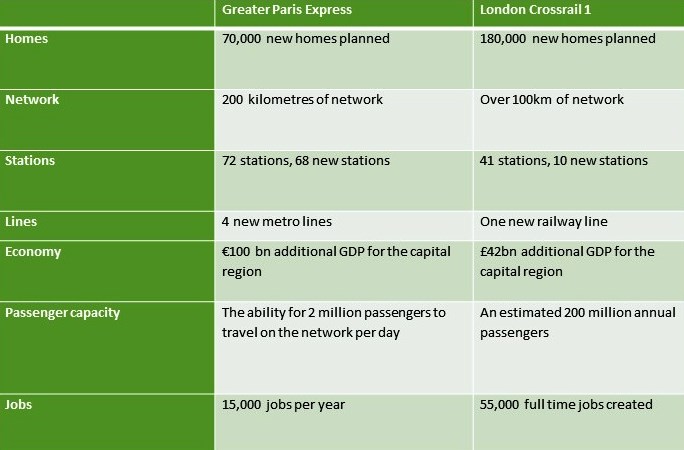The Greater Paris Express: what is it?
The Greater Paris Express, also known as the GPE, is a new public transportation extension project that is being built in and around Paris. It involves the creation of four new metro lines, as well as the construction of new stations on already existing lines, and is being deployed between now and 2030.
The implications of this project on the city of Paris itself and the Greater Paris region will be huge, and the advantages are significant. The major advantage of this project is the time commuters will save, given that the objective is to reduce commuting time in general, especially to and from various office hubs. For example, the time that it takes to reach the business district of La Défense in the east from Pont-de-Sèvres in the south will be halved. Commuting times will also decrease from Saint-Denis Pleyel to La Défense, Noisy and the international airports. Better connections between the three rings of the city will both increase the mobility of users and accelerate the appearance of new real estate locations, whether they’re for private or office use.
Transportation projects: Greater Paris Express vs Crossrail
In Europe, a stronger inclination towards urban spreading is becoming more and more apparent meaning projects such as the Greater Paris Express and the Crossrail in London have been implemented to respond to this societal change. Their aim is to link the inner cities, where office hubs have traditionally been located, to the secondary and outer rings of the city, which have historically been less developed, in part due to limited public transportation options and long commute times. The outcome of such projects will have a positive impact on the organisation of the city, the reduction in the length of commutes, and of course, the increased development of the office market in the new locations that are being created, expanded or better served by new transportation networks.
Greater Paris Express vs Crossrail
The Greater Paris Express and the Crossrail both aim to improve connectivity, bringing people from the extended suburbs into the city centre. As a result, greater infrastructure is also planned, including new homes and the creation of job opportunities. How exactly do the two cities compare?

The Greater Paris Express and the Crossrail
There are many similarities that can be observed between the two cities of Paris and London. Both have historical, highly developed underground and metro networks inside their inner cities, and both have difficulties linking their peripheries and international airports to their city centres.
London’s answer to this challenge is the Crossrail, an X-shaped transportation development project that links the outer extremities of London to each other, while also connecting the centre of the city in the process. 100 kilometres of new lines are scheduled to be created, transporting over half a million passengers each day. The projected cost is £17 billion, and while the initial delivery was set for 2017, construction delays have pushed the rollout to late 2019. The aim of this project is to make commuting easier from the centre of London to the outskirts, and to reduce crowding on the already existing lines. Crossrail will bring 1.5 million more people within a 45 minutes commute of the existing major employment centres of the West End, the City and Canary Wharf
In contrast to London’s X-shaped transportation plan, Paris has decided to construct a circular one. The reason for a circle is two-fold: firstly, it’s to better link the historically difficult-to-access outer parts of the city to each other, and secondly, it’s to connect the inner rings of the city to the two outer rings. Thanks to the construction of approximately 200 kilometres of new lines, including the creation of new stations and the extension of existing metro and suburban train lines, the GPE will transport over two million passengers daily for a projected cost of €32 billion. The major advantage that the GPE has over its London counterpart is connecting the various research, office and financial hubs in the outer rings of the city that were previously very difficult to access. After completion in 2030, these hubs will be easily accessible by all three international airports, as well as from the city centre and from other outlying suburbs, resulting in a better connection between the two million people located inside the city and the 10 million located in the outskirts.
The future of public transportation and office real estate
In conclusion, we have observed a shift from central-based city planning to more unconventional layouts in major metropolises thanks to new public transportation extension projects like the Greater Paris Express. Comparable to the Crossrail in London, the aim of such projects is to organise urban development in order to positively affect the expansion and growth of the secondary and outer rings of the city. These sectors will no longer be hard to access or require long commutes to reach them. This reduced commuting time to and from various office hubs located in the outer rings, coupled with the increased ease of transport, will accelerate mobility and the growth of businesses in these areas. Historical office hubs will be injected with new life thanks to their accessibility, new office hubs will sprout up around these extended metro lines, and an immediate rise in interest will see the appearance of new, pre-defined projects.
Other articles which might interest you:
- E-Commerce and Logistics: how is technology changing the sector?
- Breathing new life into an iconic building: the journey of BNP Paribas Real Estate and 28 Madeleine
- PropTech; what will the real estate sector look like in five years?
Sources: www.gouvernement.fr, http://www.crossrail.co.uk, http://www.grand-paris.jll.fr, BNP Paribas Real Estate research studies
-
 London
LondonGo to the BNP Paribas Real Estate UK website
-
 Paris
ParisGo to the BNP Paribas Real Estate France website




